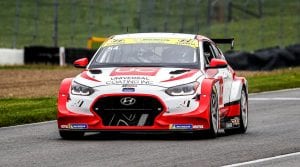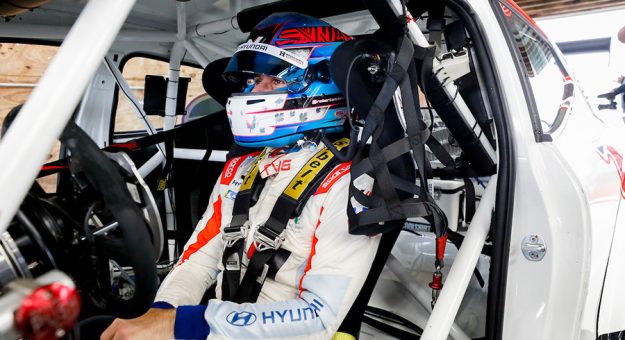MOORESVILLE, N.C. — Ever since Robert Wickens became a paraplegic after a serious crash in an NTT IndyCar Series race at Pocono Raceway on Aug. 19, 2018, he vowed he would drive a race car again.
That day came Tuesday at Mid-Ohio Sports Car Course when he drove a Hyundai Veloster for Bryan Herta Autosport. The car that competes in the IMSA Michelin Challenge was already custom fitted with hand controls for driver Michael Johnson, who is paralyzed from the chest down.
“I want to return to an elite level of motorsport again,” Wickens said. “That has been my goal since Day Zero of this journey.
“This was a massive step toward that.”
As Wickens sat in the Media Tower at Mid-Ohio Sports Car Course, IMSA’s Nate Siebens commented on the large crowd that was on the Zoom Conference.
Wickens quipped, “It must be the new suit.”
To see the fast Canadian driver back in a racing suit was a great sight for many. Prior to his horrific crash at the 2.5-mile Pocono Raceway in 2018, Wickens was one of the most promising drivers in the NTT IndyCar Series.
But that promise disappeared in a flash, as Wickens Indy car went airborne into the catchfence. By the time the mangled heap of a race car came to rest, Wickens was badly injured, including spinal injuries that have left him with extremely limited feeling in his legs.
“There were a lot of emotions after I put my visor down and get back on a race track again,” Wickens said in response to a question from SPEED SPORT. “The whole week leading up to this wasn’t so much nerves but excitement and anticipation.
“Once I put a suit on again and put in the earpieces, balaclava and helmet, it all went out the window and was like business as usual.”
But when he was on the track, the driver realized how different this type of setup is over the system he used before the crash.
“Once I got back on track, it was a slightly different story,” Wickens said. “The hand controls that Michael uses as well as the Veloster are brand new for me. Learning that on a wet track hasn’t been without its difficulties.
“The hard thing with accessibility is there is no textbook on it. With this, a lot of people in the past have raced with disabilities. You have Billy Monger, Alex Zanardi and Michael Johnson here in the IMSA series.”

The setup that Johnson uses in IMSA includes a ring on the steering wheel for throttle and braking. The driver pushes it for throttle and then hits another ring on the back of the wheel for braking. The car also has a hydraulic brake booster to help adjust the sensitivity of the brake system.
He also has a hand operated lever for the clutch, which is on the wheel, as well as a paddle-shift system.
“I think it’s a great system,” Wickens said. “Having everything within fingers reach has worked pretty good so far, but it’s a really steep learning curve. A lot of mental focus has gone in and it’s slowly getting to the point where I think less and less with it.
“We’ve been able to get quicker and quicker.
“It’s been an amazing day so far. The weather has been changing all day, but nevertheless it’s been a blast. It’s been a great day so far.”
Wickens ran around 25 laps in the morning and was waiting to return for more Tuesday afternoon.
“The Veloster is a fun little car to drive,” Wickens said. “It’s really fast and fun to drive.”
Wickens cautioned that at the moment, there are no real prospects on returning to racing. But Tuesday was a monumental day in his recovery and, hopefully, the first step to return to a racing career.
“I was never ruling it out to begin with, but the hardest thing of my injury was I was just hitting the peak of my ability when the accident happened,” Wickens said. “We’re creeping up on three years now since the accident and I’m not utilizing those prime years of my career. I would love nothing more than to get back at an elite level.
“Selfishly, I would love to get back to IndyCar to close that chapter in my life on my own terms. I would love nothing more than to win an Indy car race and then maybe move on.”
Wickens said at the early stages of his recovery, he wanted to return to IndyCar, but to do it in the current configuration with hand controls may be unfeasible.
“Never say never,” he said. “There are a lot of great teams out there and crazier things have happened in the past. For now, I’m focusing on my rehab and maybe the right opportunity will come.
“I have not been shy to admit that I want to return to an elite category again and continue my journey and my career. But getting up and running comes with finance. Until we get the world up and running again, we can get that started, but for now, it’s pretty slow.”
The most important hurdle that Wickens cleared on Tuesday, however, was the mental factor.
“There have been many tough times,” Wickens admitted. “Something a lot of people try not to talk about, but the mental health aspect of a recovery like this has been extremely daunting. It’s extremely tough. The different world of emotions that come through and the phases of your recovery, the mental aspect has been hands down, the hardest part of this recovery.
“My wife has my back and has always been there for me, but also friends and family. Sometimes, I don’t know how I got to be so lucky to have such a great support system around me.”
